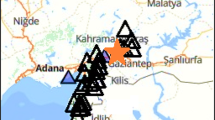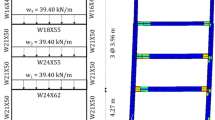Abstract
Structural damage caused by mainshock can further be aggravated by aftershocks, which can lead to structural collapse. The current practices on the seismic design of structures generally only consider mainshock effects. This manuscript therefore presents the investigation on damage-based yield point spectra (YPS) of a single-degree-of-freedom (SDOF) system under sequential earthquakes. The collected sequence-type ground motions are recorded from 16 earthquake events and classified to four classes. The aftershocks in sequence are scaled according to different relative intensity levels. The modified Park-Ang model, which consists of maximum displacement and hysteretic energy dissipation, is employed to calculate YPS. The effects of period, ductility factor, damage index, site category, aftershock intensity, and structural damping are statistically studied. The results prove that the strong aftershock ground motion has more distinct influences on the YPS. In particular, the yield strength coefficient demand under seismic sequence increases by 10%–50%. The yield strength coefficient demand determined by the damage-based YPS is greater than that determined by the ductility-based YPS—the former is 10%–40% higher than the latter. Finally, the empirical expression of damage-based YPS is established by statistical mean method and regression analysis.















Similar content being viewed by others
References
Aschheim M, Black EF (2000) Yield point spectra for seismic design and rehabilitation. Earthq Spectra 16:317–336
Aschheim M (2002) Seismic design based on the yield displacement. Earthq Spectra 18:581–600
Chopra AK, Goel RK (1999) Capacity-demand-diagram methods based on inelastic design spectrum. Earthq Spectra 15:637–656
Chopra AK, Goel RK (2001) Direct displacement-based design: use of inelastic vs. elastic design spectra. Earthq Spectra 17:47–64
Chen H, Xie Q, Li Z, Xue W, Liu K (2016) Seismic damage to structures in the 2015 Nepal earthquake sequences. Earthq Eng Eng Vib 15:173–186
Efraimiadou S, Hatzigeorgiou GD, Beskos DE (2013) Structural pounding between adjacent buildings subjected to strong ground motions. Part ii: the effect of multiple earthquakes. Earthq Eng Struct Dyn 42:1529–1545
Fajfar P (2000) A nonlinear analysis method for performance-based seismic design. Earthq Spectra 16:573–592
Freeman SA (1978) Prediction of response of concrete buildings to severe earthquake motion. Publication SP-55, American Concrete Institute, Detroit, pp 589–605
Goda K, Taylor CA (2012) Effects of aftershocks on peak ductility demand due to strong ground motion records from shallow crustal earthquakes. Earthq Eng Struct Dyn 41:2311–2330
Goda K, Salami MR (2014) Inelastic seismic demand estimation of wood-frame houses subjected to mainshock-aftershock sequences. Bull Earthq Eng 12:855–874
Hatzigeorgiou GD, Beskos DE (2009) Inelastic displacement ratios for SDOF structures subjected to repeated earthquakes. Eng Struct 31:2744–2755
Hatzigeorgiou GD (2010a) Behavior factors for nonlinear structures subjected to multiple near-fault earthquakes. Comput Struct 88:309–321
Hatzigeorgiou GD (2010b) Ductility demand spectra for multiple near- and far-fault earthquakes. Soil Dyn Earthq Eng 30:170–183
Hatzigeorgiou GD, Liolios AA (2010) Nonlinear behaviour of RC frames under repeated strong ground motions. Soil Dyn Earthq Eng 30:1010–1025
Kazama M, Noda T (2012) Damage statistics (summary of the 2011 off the pacific coast of Tohoku earthquake damage). Soils Found 52:780–792
Kotsoglou AN, Pantazopoulou SJ (2009) Assessment and modeling of embankment participation in the seismic response of integral abutment bridges. Bull Earthq Eng 7:343–361
Kowalsky MJ, Priestley MJN, Macrae GA (2010) Displacement-based design of RC bridge columns in seismic regions. Earthq Eng Struct Dyn 24:1623–1643
Kunnath SK, Reinhorn AM, Lobo RF (1992) IDARC version 3.0: A program for the inelastic damage analysis of reinforced concrete structures. Report No. NCEER-92–0022, National Center for Earthquake Engineering Research, State University of New York at Buffalo
Li Q, Ellingwood BR (2010) Performance evaluation and damage assessment of steel frame buildings under main shock-aftershock earthquake sequences. Earthq Eng Struct Dyn 36:405–427
Lu Y, Wei J (2008) Damage-based inelastic response spectra for seismic design incorporating performance considerations. Soil Dyn Earthq Eng 28(7):536–549
Moehle JP (1992) Displacement-based design of RC structures subjected to earthquakes. Earthq Spectra 8:403–428
Moon L, Dizhur D, Senaldi I, Derakhshan H, Griffith M, Magenes G, Ingham J (2014) The demise of the URM building stock in Christchurch during the 2010–2011 Canterbury earthquake sequence. Earthq Spectra 30:253–276
National Research Institute for Earth Science and Disaster Resilience (2018) Strong-motion seismograph networks (K-NET, KiK-net). https://www.kyoshin.bosai.go.jp/. Last accessed 31 December 2018
Nazari N, Van de Lindt JW, Li Y (2015) Effect of mainshock-aftershock sequences on wood frame building damage fragilities. J Perform Construct Facil 29:04014036
Negro P (1997) Experimental assessment of the global cyclic damage of framed R/C structures. J Earthq Eng 1:543–562
Pacific Earthquake Engineering Research Centre (2018) PEER ground motion database. https://ngawest2.berkeley.edu/. Accessed 13 Dec 2018
Park YJ, Ang AH (1985) Mechanistic seismic damage model for reinforced concrete. J Struct Eng 111:722–739
Powell GH (2008) Displacement-based seismic design of structures. Earthq Spectra 24:555–557
Raghunandan M, Liel AB, Luco N (2015) Aftershock collapse vulnerability assessment of reinforced concrete frame structures. Earthq Eng Struct Dyn 44:419–439
Rossetto T, Elnashai A (2005) A new analytical procedure for the derivation of displacement-based vulnerability curves for populations of RC structures. Eng Struct 27:397–409
Ruiz-García J, Negrete-Manriquez JC (2011) Evaluation of drift demands in existing steel frames under as-recorded far-field and near-fault mainshock–aftershock seismic sequences. Eng Struct 33:621–634
Safar M, Ghobarah A (2008) Inelastic response spectrum for simplified deformation-based seismic vulnerability assessment. J Earthquake Eng 12:222–248
Shen J, Ren X, Zhang Y, Chen J (2019) Nonlinear dynamic analysis of frame-core tube building under seismic sequential ground motions by a supercomputer. Soil Dyn Earthq Eng 124:86–97
Sun CX, Chen J, Zhang YQ (2016) Damage-based strength reduction factor for sequence-type ground motions. In: The 2016 structure congress, 28 August–1 September, 2016, Jeju Island, Korea
Tabatabaei R, Rahmanian MR (2012) Application of the yield point spectra (YPS) method in performance design of steel and reinforced concrete frames. J Civil Eng Res 2:18–24
Tjhin TN, Aschheim MA, Wallace JW (2007) Yield displacement-based seismic design of RC wall buildings. Eng Struct 29:2946–2959
Wang Z (2008) A preliminary report on the great Wenchuan earthquake. Earthq Eng Eng Vib 7:225–234
Zhai CH, Wen WP, Li S, Xie LL (2015) The ductility-based strength reduction factor for the mainshock–aftershock sequence-type ground motions. Bull Earthq Eng 13:2893–2914
Zhai CH, Wen WP, Chen ZQ, Li S, Xie LL (2013) Damage spectra for the mainshock–aftershock sequence-type ground motions. Soil Dyn Earthq Eng 45:1–12
Zhang Y, Chen J, Sun C (2017) Damage-based strength reduction factor for nonlinear structures subjected to sequence-type ground motions. Soil Dyn Earthq Eng 92:298–311
Acknowledgements
The authors would like to acknowledge the support from the National Natural Science Foundation of China (Grant No. U1711264), and Shanghai Jianfeng Yichang Engineering Technology Co., Ltd.
Author information
Authors and Affiliations
Corresponding author
Additional information
Publisher's Note
Springer Nature remains neutral with regard to jurisdictional claims in published maps and institutional affiliations.
Rights and permissions
About this article
Cite this article
Zhang, Y., Shen, J. & Chen, J. Damage-based yield point spectra for sequence-type ground motions. Bull Earthquake Eng 18, 4705–4724 (2020). https://doi.org/10.1007/s10518-020-00874-4
Received:
Accepted:
Published:
Issue Date:
DOI: https://doi.org/10.1007/s10518-020-00874-4




